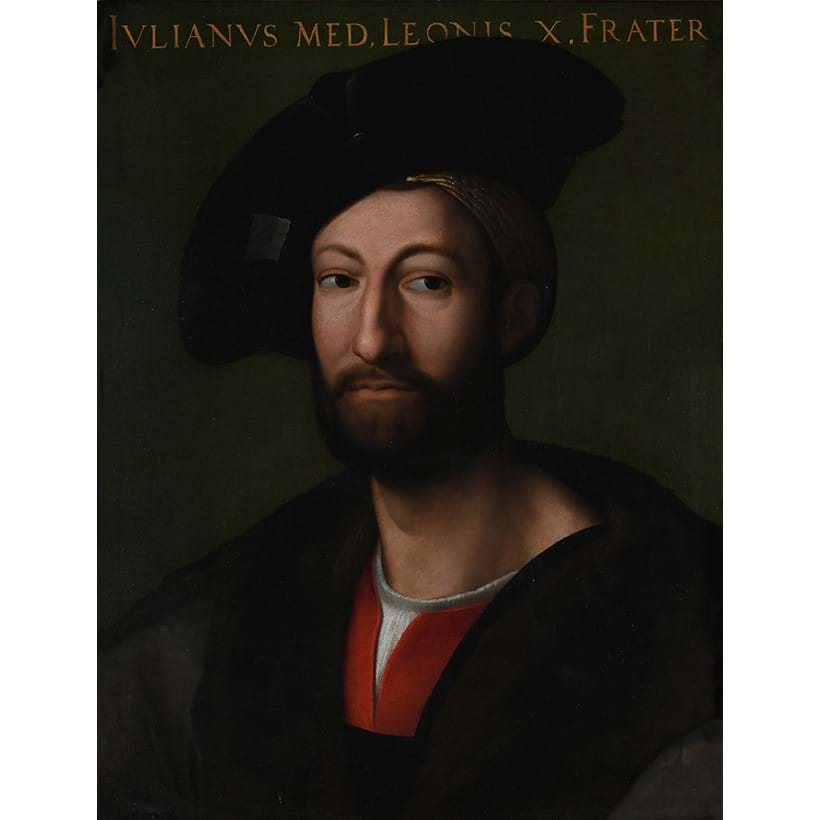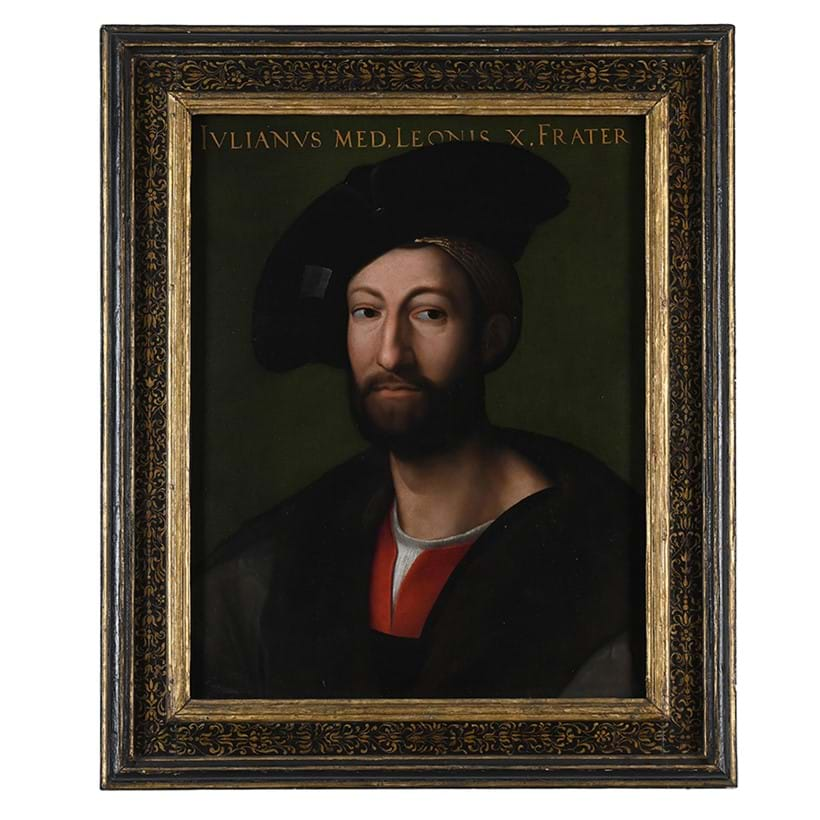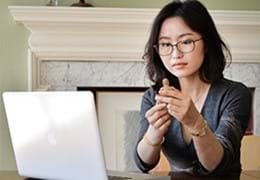Lot 11: Circle of Raffaello Sanzio, Called Raphael (Italian 1483-1520), Portrait of Guliano De Medici, Duke of Nemours
Circle of Raffaello Sanzio, Called Raphael (Italian 1483-1520)
Portrait of Guliano De Medici, Duke of Nemours
Oil on poplar
Inscribed with identifying inscription (along upper edge); with red wax seal (verso)
65 x 50cm (25½ x 19½ in.)
£30,000-£50,000 (+ fees)
Provenance:
Florentine Private Collection
Sale, Pandolfini Casa d' Aste, Florence, 26 November 2019, lot 21

We are grateful to Professor Tom Henry for having written the following essay on 24 November 2020.
There are a number of portraits of Giuliano de' Medici (1479-1516), Pope Leo X's younger brother and Duke of Nemours, but no unanimity exists regarding which of these is Raphael's original. That such a picture existed is clear from letters written within a year of the picture being painted (further discussed below), and after the sitter's death Raphael's painting spawned numerous copies, including Vasari's fresco in the Palazzo Vecchio (which was based on knowledge of Raphael's original then in the possession of Ottaviano de' Medici in Florence), and a panel attributed to Alessandro Allori in the Gallerie degli Uffizi, Florence (inv. 1890, n. 775). One version, rediscovered in the nineteenth century in Florence and now in the Metropolitan Museum of Art (inv. 49.7.12, Img X), was widely accepted as a work by Raphael in the nineteenth and early twentieth centuries but was increasingly dismissed as a copy or as a workshop replica of a lost original. The version in New York is painted on a fine canvas, and does not appear to be a transfer from a wooden support. It has suffered very extensive abrasion throughout, and there are large areas of retouching. Further comment on its compromised condition is offered by the current author in his entry on the New York picture when it was displayed in Madrid and Paris in 2012-13 (as Raphael and Workshop).
It remains to be clarified what the original looked like. The version in New York is, in fact, an outlier amongst the various versions. It shows the sitter's hands resting on a table, the top of the figure's left arm and a view beyond of the Castel Sant'Angelo and the ramparts (the Passetto) that link this building to the Vatican palace. I am only aware of one, weak, copy after this composition in its entirety, i.e. also including the Castel Sant'Angelo and a section of the Borgo Alexandrina. A second group of pictures again show the seated figure half-length, holding a letter, and it was this model that Allori followed in his later sixteenth-century copy. Notably these half-length versions all frame the figure as in the New York version. A final group only shows the head and shoulders of the sitter, always against a green curtain. The most likely scenario is that this final group is a reduced version of the larger prototype, but one cannot be sure that this was the case; and de Maffei (1959) argued that the head and shoulders format was the original solution (when promoting a version, then in a private collection, as Raphael's original). Vasari's frescoed copy in the Palazzo Vecchio could have depended on any one of these compositions. Later in the century the composition was developed as a three-quarter length by Pieter de Witte (Pietro Candido) in another painting in the Uffizi.
The early references to the picture do not help to resolve the issue. On 19 April 1516, one month after the de facto ruler of Florence Giuliano de' Medici had died, Pietro Bembo wrote to Cardinal Bibbiena and noted in passing that the portraits of the late Duke and of Baldassare Castiglione (probably a lost picture and not the portrait of Castiglione in the Louvre) 'parrebbono di mano d'uno de garzoni di Raphaello' in comparison to Raphael's portrait of Antonio Tebaldeo (also lost). This is clear evidence that Raphael, or his workshop, had painted a portrait of the Duke, perhaps to coincide with Giuliano's appointment as Captain-General of the Church in June 1515 or on the occasion of his marriage to Philiberte de Savoie in January 1515, at which time he was created duc de Nemours. That the sitter is shown with a beard apparently confirms a date in 1515 as a medal dated to this year shows that Giuliano grew a beard when he moved from Florence to Rome, where he was recorded between 31 March and 7 July 1515.
During this period there is a reference in Giuliano's household accounts to one 'Raphael of Urbino' as a salaried retainer. It is quite possible that Raphael could have received a salary of this type from the Pope's brother (a position recently restated by Carmen Bambach in her discussion of Leonardo's position in Giuliano's retinue), but in the absence of any other corroborating evidence it should be acknowledged that this individual could be a different person.
Raphael was one of the very greatest portrait painters of his age, and we know a good deal about his Roman portrait practice. As the letter referred to above suggests, and as corroborated by other correspondence, e.g. regarding the portrait of Isabel de Requesens in the Louvre, Raphael frequently relied on assistants when painting portraits. This was more commonly the case in formal, commissioned portraits and does not seem to have occurred with the (more intimate) portraits of his friends. His Roman portraiture comprises Cardinals and papal courtiers, as well as portraits of Popes Julius II and Leo X, formal portraits of members of the Medici family and of a Neapolitan beauty for King Francois Ier, as well as more intimate portraits of private citizens and friends (both male and female). The majority of these are at least half-length and include one or both of the sitter's hands.

Turning to the current painting nothing in its technique undermines the conclusion that it is a work from the first half of the sixteenth century. The picture is painted on a single poplar plank, which has a vertical grain. There is no evidence that the picture has been cut down (gesso drips are visible on the edges), and yet it is painted right up to the edges all round. It is somewhat unusual not to find an unpainted area where a panel has not been cut. The choice of panel and its preparation are otherwise typical of the period. In this period Raphael painted portraits both on canvas and on wood, and very little can be concluded from the choice of support. Formal portraits of important sitters rather than friends are more often on panel, but even here there are exceptions. The X-radiograph of this picture does not show any significant changes, but this is also not uncommon. Infra-red reflectography shows some faint drawn lines, including, strikingly, some that differ from the picture as painted (Img X). These are not easy to interpret but include an alternative (frontal) version of this portrait, and apparently a second alternative in profile, unless this is identified as the rough profile of a different individual. It is difficult to know what weight to attach to this underdrawing. Since copies generally copy a divergent underdrawing calls out for an explanation and if the profile is accepted as an alternative version of the same sitter then it raises the possibility of an artist trying one pose and then eventually selecting another. The evidential value is less if the underdrawing is unrelated, suggesting no more than that the panel might have been considered for a different purpose before settling on the image that is now visible. The underdrawing does not - in this case - have any direct attributional value. There is such a degree of variation in the underdrawing found on paintings agreed to be by Raphael that the simple lines here do not suggest Raphael was involved in the underdrawing of this panel. The drawing of the profile also has a hesitancy (a dragged and almost broken line) that might suggest it was traced and not drawn freehand. That said it does have some resemblance to the sitter as painted which is potentially significant.
Eventually assessment of the picture comes down to a close examination of its surface. The execution is of a very high quality, aspects of which require one to consider the possibility that this portrait could be by Raphael perhaps working in conjunction with his workshop as he was known to do in the field of portrait-painting (as discussed above). Amongst the reasons to give this picture serious consideration is the inscription, which is elegantly spaced and carefully adapted to fit around the sitter's hat. The Latin inscription in yellow paint reads: IVLIANVS MED. LEONIS X. FRATER (Giuliano de' Medici, brother of [Pope] Leo X). The hat also conveys much more information than is found in other versions. It is made of an unidentified black fur (the top edge where it overlaps the green curtain makes this clear), and its segmented brim is held up (instead of falling flat as a wide brim) by three (now vestigial) metal clips. The hat also has a folded paper label but no writing can be discerned (as is also the case on all of the other versions). The painting of the face is of striking quality, especially the shading and half- tones around the nose and mouth, and also the highlights and catchlights visible in the eyes which had a rare vivacity. The figure's beard and hat extend over the green background, and in an unexpected passage it seems as though some chest hair has been suggested on his body. There are also weaker areas: the fashionable hairnet and the back of the head are painted with less attention and the grey sleeves (which in other versions have quite a lot of information) are coarse and limited. Some of these discrepancies could be explained in the context of Bembo's comment about the extent of workshop involvement in Raphael's painting.
Having reviewed all these elements where does this leave the current painting? It is plainly a high quality sixteenth-century painting. The inscription is particularly fine and the divergence from the underdrawing is unusual in a copy. The most likely conclusion is that the original composition was half length and included the sitter's hands (as known in multiple versions and as was also the case in the majority of Raphael's Roman portraits) and that it may or may not have shown a view of the Castel Sant'Angelo. If this was the case then it follows that the current picture is a reduced version of Raphael's original. However it does not follow from this conclusion that the current picture should be thought of as a copy. It is increasingly clear that Raphael was open to the production of versions and replicas, and organized his workshop in order to be able to produce these as needed. Cartoons were kept in the workshop to facilitate this practice when required. Given the quality of this version it is perfectly plausible to think of it as either a reduced replica produced in Raphael's workshop or as a very early (?Florentine) copy after the original or made from such a reduction. If one examines the second proposal that it might have been painted in Florence, then the period c.1515-40 would seem to be the only possibility stylistically and it is not directly comparable with the obvious comparators from this period (Andrea del Sarto copying Raphael's Portrait of Leo X in Naples, or portraits of the Medici by Bronzino). The picture sits more happily as a secondary production of the Raphael workshop, and I suspect this picture was painted in Rome in the second half of the 1510s or the first half of the 1520s on the basis of a cartoon for the original (larger) portrait by Raphael and his workshop. It is not recognizably by any of the leading names in the workshop (Giulio Romano, GianFrancesco Penni or Giovanni da Udine), but we know that the workshop was very large and contained many talents whose intention was to reproduce Raphael's style. There has historically been a resistance to the notion that replicas were produced in Raphael's workshop, but this should be revised bearing in mind the evidence that in February 1519 Raphael explained that he had sent the cartoon of the portrait of Dona Isabel de' Requesens to Alfonso d'Este, the Duke of Ferrara, adding that this cartoon could form the basis of a replica to be executed locally, or that a replica could be executed in Rome and sent on (Shearman 2003, I, pp. 392-3, 438-9).
I was able to study the picture in person in October 2020 in the company of Simon Gillespie and Majo Prieto, and I am grateful to them and to the owner for the documentation they have provided me with.
SUMMARY BIBLIOGRAPHY (for portraits of Giuliano de' Medici)
- Vasari, Le Vite ..., Florence [1550 and 1568], eds. R. Bettarini and P. Barocchi, Le Vite ... nelle redazioni del 1550 e 1568, Florence 1966-87, IV, p. 189.
- D. Passavant, Rafael von Urbino und sein Vater Giovanni Santi, Leipzig, 1839, II, under no. 114, pp. 175-77.
J.-D. Passavant, Raphael d'Urbin et son père Giovanni Santi, Paris, 1860, II, under no. 107, pp. 145-46.
- A. Crowe and G. B. Cavalcaselle, Raphael: His Life and Works, II, London, 1885, pp. 321-23.
- Fischel, 'Porträts des Giuliano de' Medici, Herzogs von Nemours', Jahrbuch der königlich preuszischen Kunstsammlungen, 28 (1907), pp. 117-130.
- Fischel, Raphael, London, 1948, pp. 114, 365.
- de' Maffei, 'Il ritratto di Giuliano, fratello di Leone X, dipinto da Raffaello', L'arte, 1959, pp. 309-36.
- Dussler, Raphael: A Critical Catalogue of his Pictures, Wall-Paintings, and Tapestries, London, 1971, p. 41.
- Langedijk, The Portraits of the Medici, 15th-18th Centuries, II, Florence, 1983, pp. 1047-51. Raffaello a Firenze: dipinti e disegni delle collezioni fiorentine, exh. cat., Palazzo Pitti, Florence, 1984, pp. 231-233.
- Shearman, Raphael in Early Modern Sources (1483-1602), New Haven and London 2003, pp. 201-3, 220, 240-41.
- Meyer zur Capellen, Raphael: A Critical Catalogue of His Paintings, Vol. 3 The Roman Portraits, ca. 1508-1520, Landshut, 2008, pp. 14-16 and under no. A22, pp. 183-188
- Henry and P. Joannides, Late Raphael / El Último Rafael / Raphaël, les dernières années, exh. cat., Madrid (Museo del Prado) and Paris (Musée du Louvre) 2012, under no. 72, pp. 262-65.
Auction Details
Tuesday 4 November 2025, 10.30am GMT
Dreweatts, Donnington Priory, Newbury, Berkshire RG14 2JE, UK
Bidding is available in person at our salerooms, online, by telephone or you can leave commission (absentee) bids.
Browse the auction
Sign up to email alerts
Viewing in London (Highlights):
Dreweatts, 16-17 Pall Mall, St James’s, London SW1Y 5LU, UK
Friday 17 - Wednesday 22 October (no weekend viewing)
Viewing in Newbury (Full sale):
Dreweatts, Donnington Priory, Newbury, Berkshire RG14 2JE, UK
Saturday 1 - Monday 3 November
Further information:
General enquiries: + 44 (0) 1635 553 553 | pictures@dreweatts.com
Press enquiries: press@dreweatts.com











